Digital Poster
Imaging Findings in Psychiatric Disorders
Joint Annual Meeting ISMRM-ESMRMB & ISMRT 31st Annual Meeting • 07-12 May 2022 • London, UK

| Computer # | ||||
|---|---|---|---|---|
2024 |
14 | Structural abnormalities in patients with early psychosis: a MP2RAGE-based morphometric study at 7T
Zirun Wang1, Martine Cleusix2, Raoul Jenni2, Philippe Conus3, Kim Q. Do2, and Lijing Xin1
1Animal imaging and technology core (AIT), Center for Biomedical Imaging (CIBM), Ecole Polytechnique Fédérale de Lausanne (EPFL), Lausanne, Switzerland, 2Center for Psychiatric Neuroscience, Department of Psychiatry, Centre Hospitalier Universitaire Vaudois (CHUV) and University of Lausanne (UNIL), Lausanne, Switzerland, 3Service of General Psychiatry, Department of Psychiatry, Centre Hospitalier Universitaire Vaudois (CHUV) and University of Lausanne (UNIL), Lausanne, Switzerland This study aims to investigate grey matter alterations in early psychosis patients (n = 44) compared to healthy control subjects (n=30). Morphometric analysis using MP2RAGE images at 7T. VBM did not reveal significant cluster after FWE (Family-Wise Error) corrections, but suggested grey matter reduction (uncorrected p<0.005) in the globus pallidus, right thalamus, left inferior temporal gyrus, left superior parietal, left paracentral lobule, left precuneus, right parietal lobe (postcentral gyrus) of patients compared to healthy subjects. |
||
2025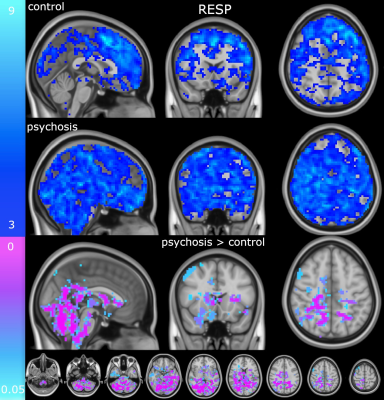 |
15 | Altered brain pulsations in phychosis.
Emma Hiukka1, Heta Helalari1, Vesa Korhonen1, and Vesa Kiviniemi1
1Radiology, Oulu University, Oulu, Finland
The detection of functional alterations in psychotic subjects has proven to be a demanding task. In this study we used ultrafast fMRI to investigate physiological brain pulsations driving blood and CSF convection in psychotic brain. We detected dichotomized changes in opposing brain region pulsations between the upper frontal and lower posterior parts of the brain in all three major brain pulsations. The altered brain pulsations in psychotic brains may be connected to abnormal convection of metabolites via CSF and blood providing an physiological basis for the altered reality experiences in psychosis.
|
||
2026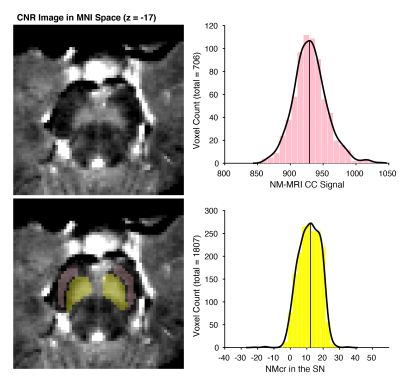 |
16 | Neuromelanin MRI as biomarker for treatment resistance in first episode schizophrenia patients
Marieke Van der Pluijm1, Pascalle Nadine Reijers1, Kenneth Wengler2, Lieuwe De Haan1, Jan Booij1, Guillermo Horga2, and Elsmarieke Van de Giessen1
1Amsterdam UMC, Amsterdam, Netherlands, 2Columbia University Medical Center, New York, NY, United States
The current study assesses neuromelanin sensitive MRI (NM-MRI) as a potential biomarker for treatment resistance (TR) in first episode schizophrenia patients. NM-MRI is a novel MRI sequence, which indirectly measures dopamine synthesis. Research using positron emission tomography (PET) imaging suggest that TR patients show lower dopamine synthesis than responders. We acquired NM-MRI in 61 first episodes schizophrenia patients. Treatment response was determined during 6 months follow-up. TR patients showed significantly lower NM-MRI signal compared to responders. These findings are in line with previous PET studies and demonstrate the potential of NM-MRI as alternative and more accessible biomarker for TR.
|
||
2027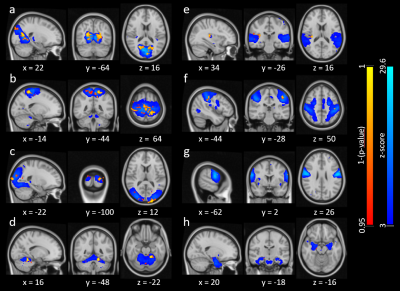 |
17 | Independent component analysis of rsfMRI data in pedophilic disorder: A Swedish case control study Video Permission Withheld
Linnéa Andersson1, Christoffer Rahm2, Benny Liberg2, Maria Ljungberg1,3, and Isabella M. Björkman-Burtscher4,5
1Department of Medical Physics and Biomedical Engineering, Sahlgrenska University Hospital, Gothenburg, Sweden, 2Department of Internal Medicine, Karolinska Institute, Stockholm, Sweden, 3Department of Medical Radiation Sciences, Institute of Clinical Sciences, Sahlgrenska Academy, University of Gothenburg, Gothenburg, Sweden, 4Department of Radiology, Institute of Clinical Sciences, Sahlgrenska Academy, University of Gothenburg, Gothenburg, Sweden, 5Department of Radiology, Sahlgrenska University Hospital, Gothenburg, Sweden
Fifty percent of all child sexual abuse (CSA) perpetrators are individuals with pedophilic disorder. The neural underpinnings of pedophilic disorder are unknown. We conducted a case-control study aiming to investigate functional connectivity alterations using independent component analysis on resting state fMRI data in search of biomarkers that can be used for preventing CSA. The results suggest there are functional connectivity alterations in several resting state networks in individuals with pedophilic disorder.
|
||
2028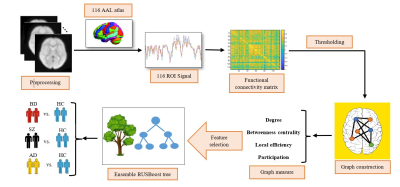 |
18 | Diagnosis of Schizophrenia, Bipolar, and Attention Deficit Hyperactivity Disorders using Graph-Theory Features of Resting-State fMRI
Faezeh Ghasemi1,2, Hosna Tavakoli3,4, Saeed Masoudnia 4, Narges Hoseini Tabatabaei5, Reza Rostami6, and Mohammad-Reza Nazem-Zadeh4,7
1Medical Physics and Engineering, Shahid Beheshti University of Medical Sciences, Tehran, Iran (Islamic Republic of), 2Research Center for Biomedical Technologies and Robotics, Tehran University of Medical Sciences, Tehran, Iran (Islamic Republic of), 3cognitive neuroscience, Institute for Cognitive Science Studies, Tehran, Iran (Islamic Republic of), 4Research Center for Molecular and Cellular Imaging, Tehran University of Medical Sciences, Tehran, Iran (Islamic Republic of), 5Medical School, Tehran University of Medical Sciences, Tehran, Iran (Islamic Republic of), 6Department of Psychology, University of Tehran, Tehran, Iran (Islamic Republic of), 7Medical Physics and Biomedical Engineering, Tehran University of Medical Sciences, Tehran, Iran (Islamic Republic of)
Accurate and specific diagnosis of mental disorders is very important for effective, customized, and personalized treatments, which would be made more possible based on individual neuroimaging data. In this study, we classified schizophrenia (SZ), bipolar disorder (BD), and attention deficit hyperactivity disorder (ADHD) cohorts, vs. healthy control (HC) cohort, using extracted graph features from Resting-State fMRI (rs-fMRI) images. The graph-based connectivity features of limbic, auditory, visual, and default mode networks were identified as the most separating features for the SZ, BD and, ADHD groups from the HC group among brain networks.
|
||
2029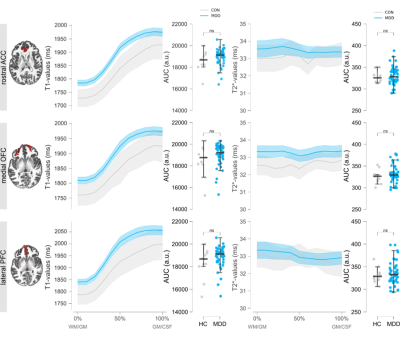 |
19 | Quantitative MRI in Major Depressive Disorder at 7T
Jurjen Heij1, Wietske van der Zwaag1, Matthan W.A. Caan2, Guido van Wingen3, and Moji Aghajani4
1Spinoza Centre for Neuroimaging, Amsterdam, Netherlands, 2Department of Biomedical Engineering, Amsterdam UMC, Amsterdam, Netherlands, 3Department of Psychiatry, Amsterdam UMC, Amsterdam, Netherlands, 4Institute of Education and Child Studies, University of Leiden, Leiden, Netherlands
Large scale efforts are being employed to link Major Depressive Disorder (MDD) to cortical alterations in gray and white matter, though often, limited resolution prevents conclusions regarding the source. Here we used quantitative 7T MRI to explore the myeloarchitecture of the cortex in people suffering from MDD in order to unravel potential mechanisms underlying the psychopathology of MDD. We find altered T1-profiles in the rostral ACC, lateral PFC and OFC in MDD compared to healthy controls, indicating changes in cortical myeloarchitecture. Overall, cortical T1 values were higher in MDD, suggesting lower cortical myelination.
|
||
2030 |
20 | Ketamine Induced Glutamate Alternations in Treatment-Resistant Depression. A 1H-MRS randomised placebo controlled study.
Rouslan Sitnikov1,2, Mikael Tiger3, and Johan Lundberg3
1Neuroradiology, Karolinska University Hospital, Stockholm, Sweden, 2Clinical Neuroscience, MR Center, Karolinska Institutet, Stockholm, Sweden, 3Centre for Psychiatry Research, Karolinska Institutet & Stockholm Health Care Services, Region Stockholm, Stockholm, Sweden Background: The glutamate N-methyl-D-aspartate receptor antagonist ketamine has a rapid antidepressant effect in major depressive disorder (MDD) patients. Though, the ketamine's possible mechanism of action has been debated the main hypothesis was focused around glutamate. Methods: A proton short-echo MR Spectroscopy was utilised to examined three brain regions Anterior Cingulate Cortex, Hippocampus and Raphe nuclei before and 24-hours after treatment. 28 Selective Serotonin Reuptake Inhibitor resistant MDD patients were randomized to double blind monotherapy with 0.5 mg/kg ketamine or placebo infusion. Results: glutamate correlates with depression symptoms severity in ACC and HC in opposing ways in ketamine group. |
||
2031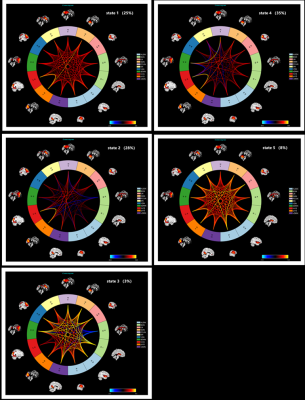 |
21 | Aberrant Dynamic Functional Network Connectivity in Adult Patients With Autism Spectrum Disorder Video Not Available
Xipeng Yue1, Yan Bai1, Ge Zhang1, Yu Shen1, Xianchang Zhang2, and Meiyun Wang*1
1Henan Provincial People’s Hospital, Zhengzhou, China, 2MR Collaboration, Siemens Healthineers Ltd., Beijing, China
Conventional static functional connectivity analysis does not capture transient and atypical changes in functional connectivity between neural networks in the autism spectrum disorder (ASD) patients. In this study, we evaluated rsfMRI data of 108 adult ASD patients by dynamic functional network connectivity (dFNC) analysis using sliding time window correlation and K-means clustering methods. Our results showed that higher dwell time and altered functional connectivity between multiple nodes in FNC state 2 correlated with clinical ASD scores. Therefore, our study demonstrates that aberrant and transient functional connectivity changes between neural networks in ASD patients can be evaluated by dFNC analysis.
|
||
The International Society for Magnetic Resonance in Medicine is accredited by the Accreditation Council for Continuing Medical Education to provide continuing medical education for physicians.